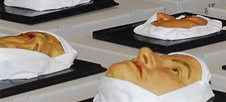History of Moulage Production
Skin rashes were described as far back as 2000 years ago. However, they were not interpreted as skin diseases. It was perceived that the skin as the shell and exchange surface of the body contributed to the maintenance of the inner balance of bodily fluids (humors). Skin appearances were an expression of disturbances of this inner balance.
Only after the skin was regarded as an organ with independent "skin diseases", and the specialty of skin and venereal diseases began to develop did it become necessary to describe the different skin pathologies as precisely as possible and to record them in pictures and reproductions.
The art of wax sculpting (ceroplastics) was used to produce anatomical models as early as in the 17th and 18th century. Shortly after the publication of the first texts on skin diseases around 1800, the first wax casts (moulages) of skin rashes were made.
One of the first "mouleurs" was probably Franz Heinrich Martens (1778 - 1805), a private lecturer in Jena, who, according to a quote from Johann Wolfgang Goethe, "tried to depict particularly pathological curiosa, especially syphilitic cases of disease, in dyed wax with the greatest accuracy".
In England, Joseph Towne (1808 - 1879) manufactured over 1000 dermatological, pathological and anatomical wax models during his 53 years at Guy's Hospital in London.
Of particular importance is the moulage collection of the Hôpital St. Louis in Paris, one of the first clinics for skin diseases in Europe. Under the direction of Charles Lailler (1882 - 1898), Jules Baretta (1834 - 1923), who had originally sold artificial wax fruits in his own studio, produced over 3000 moulages of interesting and typical skin and venereal diseases.
The exhibition of his moulages at the first International Congress for Dermatology and Syphiligraphy in 1889 at the Hôpital St. Louis in Paris impressed specialists from all over Europe and overseas to such an extent that moulage collections were subsequently set up at many clinics. This resulted in large collections in Vienna, Breslau, Freiburg i.Br., Berlin, but also in Athens, Moscow and Tokyo. Most mouleurs developed their own recipe and technique and strictly kept it secret. The technique still used in Zurich today was passed on by Fritz Kolbow from Berlin to his student Lotte Volger and modified by her.
